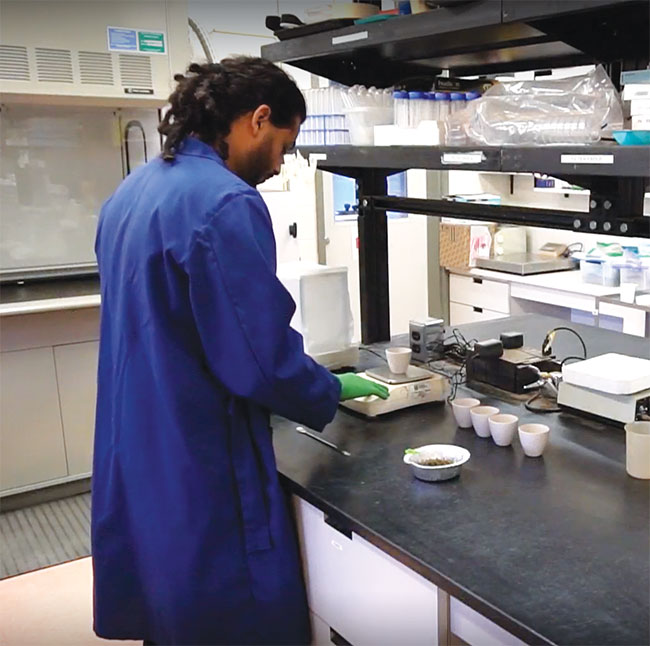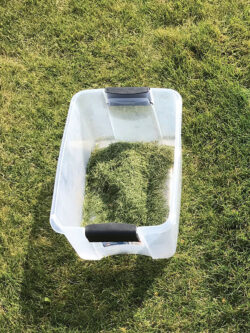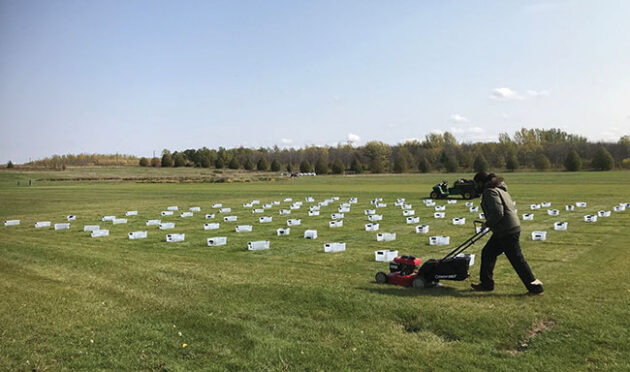
Features
Agronomy
Eco-Friendly Practices
Turf Revival
Are biosolids good for turf, or just bull? Research looks at practicality, sustainability
Here’s the ‘poop’ on biosolids research
September 1, 2023 By By Dr. Sara Stricker Based on research by Vighnesh Lakshmana Sukhu, MSc
 Vighnesh Lakshmana Sukhu, MSc, measures soil organic matter content in the lab.
Photo credit: Guelph Turfgrass Institute
Vighnesh Lakshmana Sukhu, MSc, measures soil organic matter content in the lab.
Photo credit: Guelph Turfgrass Institute The turfgrass industry is always looking for innovative solutions for age-old problems. To maintain a healthy and functional turf stand, we strategically apply fertilizers. Unfortunately, the demand for conventional synthetic fertilizers is on the rise and the future availability and sustainability of these products is uncertain.
Synthetic fertilizers typically contain the three plant macro-nutrients which are nitrogen (N), phosphorous (P) and potassium (K). Nitrogen is manufactured using the Haber-Bosch process which creates ammonia by heating and pressurizing nitrogen from the air over a hydrogen source such as natural gas or coal. Phosphorus is extracted from mined phosphate rock using sulfuric acid. The largest deposit of phosphate is found in North Carolina. Potassium originates as potash, which is also known as potassium chloride. Approximately 30 per cent of the world’s potash is mined from an area of Saskatchewan, which was an ancient inland sea.
The mining process for these raw materials is environmentally destructive and the manufacturing process creates waste products such as phosphogypsum, which may contain radioactive materials. We also know that the inappropriate use of fertilizers can lead to salt accumulation, chemical leaching, fertilizer runoff and poor soil health.
If we look back into history, we can see evidence of fertilizer use going back into the age of ancient Romans. Wood ash would be spread on fields, which had a similar effect as agricultural lime. Wood ash contains calcium, potassium, phosphorus, and magnesium. In terms of commercial fertilizer, wood ash would be about 0-1-3 (N-P-K). An archaeobotanist at the University of Oxford states that we have been using livestock manure for nearly 8,000 years. In one study, chicken litter was evaluated to be 0.14-0.07-0.06, swine pit slurry was 8-4-5, and dairy cow manure was 46-19-33. Guano (excrement from seabirds) has been used in Peru for more than two thousand years. The guano of seabirds is highly effective due to their diet of fish and is packed with nitrogen, phosphate, and potassium. This guano fertilizer clocks in at about 12-12-3, but the N-P-K composition of guano will vary based on the bird species and location in the world.
Long story short – “organic” fertilizers are old news!
The poop on biosolids
What if I told you there is a more local source of macro-nutrients, and you won’t need to chop wood, chase birds or muck out a pig pen? In fact, every household in Canada is a source for this pipeline of fertilizer… but we prefer to call it “biosolids.”

Clippings are collected at a trial plot at the Guelph Turfgrass Institute.
That doesn’t mean we are spreading raw human sewage! Not only would it smell horrendous, but it would pose a significant risk for spreading human and animal pathogens. Biosolids are nutrient-rich materials that are produced from purified human waste to create fertilizers.
What do we currently do with our poop? Rural homes have septic tanks; the waste gets flushed, accumulated in an underground tank, concentrated over time, and then eventually pumped out when the tank is full. The septic contents are then either piped into a nearby municipal system or dumped in specific landfills. Municipal wastewater systems will use a combination of physical and chemical filters to remove solids, nutrients, and contaminants and the remaining wastewater is then released into a nearby lake or river. Unfortunately, none of the wastewater management systems currently in place is infallible – some pollutants are inevitably released into the environment while processing human sewage.
Fertilizing turfgrass with biosolids provides an alternative pathway for biosolids that is practical, environmentally friendly and sustainable. We seem to have an endless supply of this kind of manure. Also, since is it unlikely that someone will turn their lawn into a salad, we have a much lower risk for spreading human pathogens when using biosolids on turf as opposed to on other agricultural crops. Not that we should go completely wild – it is still important to process and sterilize the sewage before application to turf!
Biosolids do not pose the same environmental risks as inorganic fertilizers (less leaching and volatilization), and they provide organic matter and essential nutrients to improve health and soil quality. We need to be a little careful about the salt and ammonia levels from human waste (which can cause burn symptoms), but the iron content of biosolids can lead to a dark-green colour which is desirable. Studies have also shown increased microbial activity in soil treated with biosolids, which can support and bolster the natural nitrogen cycle. This leads to healthier turf and possibly… less disease?
If you’ve been in the turf business for a few years, you might recall a product called Milorganite. This biosolid fertilizer is produced in Milwaukee, Wis., but product can no longer be shipped to Canada. In 2015 the Canadian Food Inspection Agency set a ruling that the allowable detection limit for pathogens in fertilizers should mimic the standards for food products. This seems a tad extreme, since processed biosolids should be sterile, but that’s beyond our control. This legislation means that biosolid products need to be produced locally.

Photo credit: Guelph Turfgrass Institute
Biosolids and disease suppression
In a study at the University of Guelph, the application of biosolids produced in Cambridge and Toronto suppressed dollar spot disease to levels comparable with the inorganic fertilizer and significantly lower than the non-fungicide/non-fertilized control. Unsurprisingly, the fungicide treatment was the best at suppressing dollar spot, but it is promising to think that biosolids could be incorporated into a management regime in a way that reduces disease AND risk of fertilizer leaching in one fell swoop. The biosolids reduced dollar spot disease severity by 29–59 per cent compared to the control.
In addition to providing disease suppression, a second experiment by the same researcher captured soil health data. All treatments resulted in similar soil organic matter content and aggregate stability, but the microbial respiration for the Lystek biosolid treatment was often the highest. One of the two biosolid treatments slightly decreased the soil pH, which may mean that pathogens that cause take-all patch and pink snow mould would be suppressed at this lower soil pH, but we don’t have data on those diseases to make a solid conclusion. We also think that repeated use of biosolid and manure products will have added impacts on soil and turf health, but a longer trial would be needed to capture those effects.
At the end of the day, are we ready to completely replace commercial fungicides and synthetic fertilizers with human manure products? No.
But could they be used in addition to other products to reduce disease severity and improve soil health? YES! Give it a go. Don’t flush these findings out. Maybe biosolids could be your “number two” option.
For more information about the Guelph Turfgrass Institute, visit www.GuelphTurfgrass.ca or follow @GuelphTurf on social media. Read the full thesis this article was based on at https://hdl.handle.net/10214/26336
Print this page